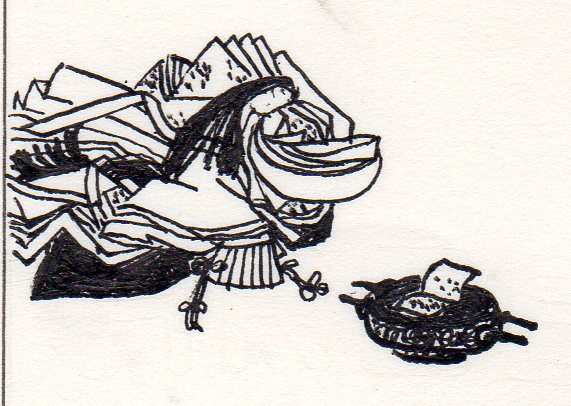|
||
 |
||
1 Shimizu Komachi 清水小町. Perhaps based on an episode in the YAMATO MONOGATARI 大和物語 (Tales of Yamato; Chap.168), when Komachi exchanges poems with the priest Henjou 遍照 at Kiyomizudera 清水寺 (shimizu is an alternate reading of kiyomizu). The poem added to this scene, however, differs from that in the Tales of Yamato and reads: What is happening--does the belt fall heedlessly from the body? The scenery of a waterfall is something that never changes." [Nani wo shite/mi wo itazura ni/obi token//taki no keshiki wa/kawaranu mono wo 何をして/身をいたづらに/帯とけん//滝のけしきは/かはらぬものを]. Representations of this motif typically show a beautiful woman paired with the Otowa Falls, Otowa-no-taki 音羽の滝 at Kiyomizudera 清水寺 during the cherry-blossom season.
2 Amagoi Komachi 雨乞小町. Lit. rain prayer Komachi. Komachi ends a drought by offering the following poem as a prayer for rain: It is only reasonable since this is the Land of the Rising Sun for the sun to shine. Nevertheless it is also called ama-ga-shita (both 天 [heaven] and 雨 [rain] reads ame/ama). [kotowari ya/hi no moto nareba/teri mo sen//saritote wa mata/ama ga shita towa ことはりや/日のもとなれば/てりもせん/さりとては又/天が下とは]. Usually depicted is the petitioning Komachi by the shore of a pond in heavy rain with a servant behind her opening a long-hand umbrella.
3 Soushi-arai Komachi 草紙洗小町. Lit. Komachi washing a book. The night before a poetry contest at the Imperial Palace, Ootomo no Kuronushi 大伴黒主 overhears his rival, Ono no Komachi, recite her entry aloud to herself. Hoping to disqualify her, he writes it into a copy of the MAN'YOUSHUU 万葉集, and on the day of the competition accuses her of plagiarism. However, Komachi washes (arai) the book (soushi), whereupon the fresh ink washed away and exposes Kuronushi's scheme. The poem reads: No one has sown it--from what seed issues the floating grass which in the watery furrow of the waves sprouts and grows thick? [Makanakuni/nani wo tane tote/ukikusa no//nami no une-une /oishigeruran まかなくに/何をたねとて/うき草の//浪のうねうね/おひしげるらん].
4 Kayoi Komachi 通小町. Captain Fukakusa, Fukakusa no Shoushou 深草少将 fell in love with Komachi. She promised to spend a night with him if he slept 100 nights outside her door. The captain braves the elements for 99 nights, marking each night by notch on the carriage shaft bench, but expires on the 100th. The poem reads: One hundred times or more, I hear the fluttering of the snipes' wings as I count the lonely hours till dawn when you have not come. [Akatsuki no/shiji no hanegaki/momohagaki//kimi ga konuyo wa/warezo kazukazu あかつきの/しじのはねがき/ももはがき//きみがこぬ夜は/われぞかずかず]. Typically in painting the captain is visiting Komachi by an oxcart on a snowy night.
5 Oumu Komachi 鴎鵡小町. The emperor sends a poem of pity to the aged Komachi: Although above the clouds things do not change from how they were in the past, do you look back fondly on your time spent within the jeweled curtains? [Kumono ue wa/arishi mukashi ni/kawaranedo//mishi tamadare no/uchiya yukashiki 雲のうへは/ありしむかしに/かはらねど//見し玉だれの/うちや床しき]. By changing only one word of the emperor's poem (ya to zo), Komachi demonstrates that age has not dulled her wit: Although above the clouds things do not change from how they were in the past, I do indeed look back fondly on my time spent within the jeweled curtains. Illustrations frequently include either a parrot or a parrot painted on a single-leaf screen, because to repeat another's words mechanically is called "parrot's repetition oumugaeshi 鴎鵡返し.
6 Sekidera Komachi 関寺小町 The priest of Sekidera, accompanied by a child, visited the aged Komachi to discuss poetry. The child invited her to the temple, where the Tanabata 七夕 Star Festival was held. The child danced and then Komachi danced, too, forgetting her age. The poem reads: Wretch that I am - a floating waterweed, broken from its roots. If a stream should beckon, I would follow it, I think (trans. Keene). [Wabinureba/ mi wo ukikusa no/ne wo taete//sasou mizu araba/ inantozo omou わびぬれば/身をうき草の/ねをたへて/さそふみづあらば/いなんとぞ思ふ].
7 Sotoba Komachi 卒塔婆小町. A travelling monk reprimanded an old woman for resting her aged body disrespectfully on a stupa. He found that the woman was a withered Komachi, who started to talk about the tragic love with Captain Fukakusa. After her confession, his soul attained peace. The poem read: Were I in Heaven the stupa were an ill seat. But here, in the world without, what harm is done? [Gokuraku no/michi nareba koso/ashikarame//soto wa nanikawa/kurushi karuran 極楽の/道なればこそ/あしからめ//そとは何かは/くるしかるらん].

Soushi-arai Komachi 草紙洗小町
(C)2001 Japanese Architecture and Art Net Users System. No reproduction or republication without written permission.
掲載のテキスト・写真・イラストなど、全てのコンテンツの無断複製・転載を禁じます。

